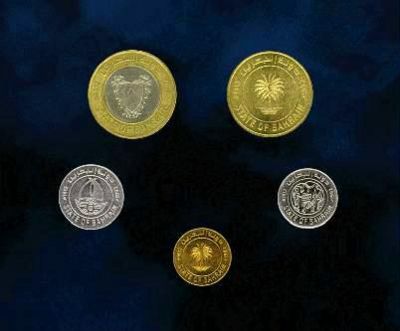巴林第纳尔
出自 MBA智库百科(https://wiki.mbalib.com/)
巴林第纳尔(Bahrain Dinar 原符号:BD. 标准符号:BHD)
目录 |
巴林所有的钞票均由巴林货币局发行。
巴林纸币的尺寸随面额大小而变化,最大面额20第纳尔的尺寸为:16.0×8.0厘米,而最小面额0.5第纳尔的尺寸仅为:14.5×64厘米。巴林铸币质地为:铜、锌、镍合金。
巴林原使用特种印度卢比,比价为13.3333卢比等于1英镑,4.619卢比等于1美元。1965年10月16日,巴林发行本国货币,规定第纳尔含金量为1.86621克。官方汇率为2.10美元,等于1第纳尔,或0.47619第纳尔等于1美元,1.33333第纳尔等于1英镑,并以1:10的汇率收回特种印度卢比。1972年6月26日巴林第纳尔与英镑脱钩,改钉住美元,1978年1月18第纳尔与美元脱钩,改与特别提款权挂钩,建立了管理浮动汇率制,8月15日浮动范围从2.25%扩大到7.25%。特别提款权等于0.476190巴林第纳尔。自1980年以来,巴林第纳尔与美元的比价为1第纳尔等于2.6596美元。
目前市面上共有五种面额的纸币流通,面额分别是:0.5、1、5、10、20第纳尔。
铸币有5、10、25、50、100弗尔铸币同
巴林辅币进位是:1第纳尔等于1000弗尔(Fils)。
The history of currency in Bahrain and the Bahrain Dinar
The Umayyad governors of Bahrain made the first coins of Bahrain during the eighth century, although for the next thousand years most coins in use in Bahrain were either imported or locally struch in imitation of foreign coins. British gold sovereigns and the silver Maria Theresa Thalers were widely used well into the 1960's even after local banknotes and coins were long since established. The Indian rupee was the official currency of Bahrain up until 1959, when it was replaced at a 1:1 ratio by the Gulf rupee issued by the Reserve Bank of India which was created for use in the Persian Gulf to reduce the drain on India's foreign currency reserves. The original Indian rupee was divided into 16 Annas but when the Gulf rupee was introduced in was decided to make it divisible by 100 Naye Paisa. The Gulf rupee notes looked similar to the then current Indian rupee notes but were different in colour.
India devalued its' currency in 1966 which affected the value of the Gulf rupee as well, this intern forced countries using the gulf rupee to look for an alternative or introduce their own currencies. Bahrain chose to introduce its' own currency in 1965, the Bahraini Dinar which replaced the Gulf rupee at a rate of 1 Dinar was eqaul to 10 Gulf rupees. The new currency was divided into 1000 fils.
Bahrain's first banknotes were issued by the Bahrain Currency Board from 1965 until 1973 and from 1973 till present the Bahrain Monetary Agency has played this role.
Bahrain, and the United Arab Emirates and Qatar had an interchangeability agreement for banknotes starting in January 1978. The rates of interchange were 10 Qatari riyals = 1 Bahrain dinar = 10 United Arab Emirates dinars, up to 5,000 Qatari riyals, 500 Bahrain dinars, or 5,000 United Arab Emirates dinars. The agreement fell apart in May 1979 after Qatar revalued its currency.
Banknotes in Bahrain currently in circulation come in denominations of 1/2 Diner or 500 fils, 1 Dinar, 5 Dinars, 10 Dinars and 20 Dinars. Coins come in denominations of 500 fils, 100 fils, 50 fils, 25 fils and 10 fils.
The Bahraini Dinar is locally written as BD and prices are normally written to three decimal places as the currency is divided into 1000. Bahrain's currency ISO code is BHD. The Bahrain Dinar is currently the third most valuable currency unit in the world after the Kuwaiti Dinar and the Maltese Lira.
The unauthorized second printing of the Bahraini 20 Dinar banknote. A group of confidence men passing themselves to be representatives of the Bahrain Monetary Agencyillegally ordered these 20 Dinar notes from the Argentinian security printer Ciccone Calcografica. More then 75,000 of these fake 20 Dinar of 1.5 million Dinars worth of the dubious notes were presented for payment at various branches of the Bahrain Monetary Agency in the United Arab Emirates from 4 to 11 June 1998. At this time the notes were discovered to be slightly different from the notes currently in circulation. The Bahrain Monetary Agency imeadiatly contacted their printer Thomas de la Rue in London to find out if there had been any changes to the plates used to print the 20 Dinar notes, which of course Thomas de la Rue said there were none. The genuine 20 Dinar notes were consequently withdrawn from circulation on 30 July 1998. The Bahrain promptly replaced the purple 20 Dinar note with a peach coloured version of the same design.
The Argintinian notes can be distinguished from the originals by the spacing between the first two Arabic letters of the horizontal serial number found in the bottom right of the front of the note and by the difference in shading in the panel behind the name in Arabic of the Bahrain Monetary Agency on the front.




























